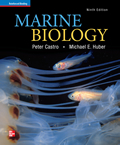
Marine Biology (Castro), 9th EditionChapter 17: Resources from the SeaFor Further ReadingS. J. Cook and I. G. Cowx, 2004. The role of recreational fishing in global fish crises. BioScience, vol. 54, no. 9, pp. 857–859. Recreational fishing is a significant component of the overfishing problem. J. A. Hutchings and J. D. Reynolds, 2004. Marine fish population collapses: consequences for recovery and extinction risk. BioScience, vol. 54, no. 4, pp. 297–309. Rapid declines in the populations of many fishes draw attention to the need of knowing more about the ecology, behavior, and evolution of these depleted species. Nelson, L., 2004. One slip and you’re dead. Nature, vol. 429, 24 June, pp. 798–799. Potential drugs from cone shells, or conotoxins, are under investigation, some undergoing clinical trials. Wolman, D., 2004. Hydrates, hydrates everywhere. Discover, vol. 25, no. 10, October, pp. 62–68. A novel plan to convert seawater into fresh water. Braithwaite, R. A. and L. A. McEvoy, 2004. Marine biofouling on fish farms and its remediation. Advances in Marine Biology, vol. 47, pp. 215–252. Coleman, F. C.,W. F. Figueira, J. S. Ueland and L. B. Crowder, 2004. The impact of United States recreational fisheries on marine fish populations. Science, vol. 305, no. 5692, 24 September, pp. 1958–1960. Donia, M. and M. T. Hamann, 2003. Marine natural products and their potential applications as anti-infective agents. The Lancet Infectious Diseases, vol. 3, no. 6, pp. 338–348. Dulvy, N. K., J. R. Ellis, N. B. Goodwin, A. Grant, J.D. Reynolds and S. Jennings, 2004. Methods of assessing extinction risk in marine fishes. Fish and Fisheries, vol. 5, no. 3, pp. 255–276. Fei, X., 2004. Solving the coastal eutrophication problem by large-scale seaweed cultivation. Hydrobiologia, vol. 512, no. 1, pp. 145–151. Livett, B. G., K. R. Gayler and Z. Khalil, 2004. Drugs from the sea: conopeptides as potential therapeutics. Current Medicinal Chemistry, vol. 11, no. 13, pp. 1715–1723. Lüning, K. and S. Pang, 2003. Mass cultivation of seaweeds: current aspects and approaches. Journal of Applied Phycology, vol. 15, no. 2–3, pp. 115–119. Molony, B.W., R. Lenanton and G. Jackson, 2003. Stock enhancement as a fisheries management tool. Reviews in Fish Biology and Fisheries, vol. 13, no. 4, pp. 409–432. Rose, K. A. and J. H. Cowan, 2003. Data, models, and decisions in U.S. marine fisheries management: lessons for ecologists. Annual Review of Ecology, Evolution, and Systematics, vol. 34, pp. 127–151. Salas, S. and D. Gaerter, 2004. The behavioural dynamics of fishers: management implications. Fish and Fisheries, vol. 5, no. 2, pp. 153–167. Smit, A. J., 2004. Medicinal and pharmaceutical uses of seaweed natural products: a review. Journal of Applied Phycology, vol. 16, no. 4, pp. 245–262. Spinney, L., 2003. Fishing for novel drugs. Drug Discovery Today, vol. 8, no. 17, pp. 770–771. Troell, M., C. Hailing, A. Neori, T. Chopin, A. H. Buschmann, N. Kautsky and C. Yarish, 2003. Integrated mariculture: asking the right questions. Aquaculture, vol. 226, no. 1, pp. 69–90. Tziveleka, L. A., C. Vagias and V. Roussis, 2003. Natural products with anti-HIV activity from marine organisms. Current Topics in Medicinal Chemistry, vol. 3, no. 13, pp. 1512–1535. Utter, F. and J. Epifanio, 2002. Marine aquaculture: Genetic potentialities and pitfalls. Reviews in Fish Biology and Fisheries, vol. 12, no. 1, pp. 59–77. |  |















